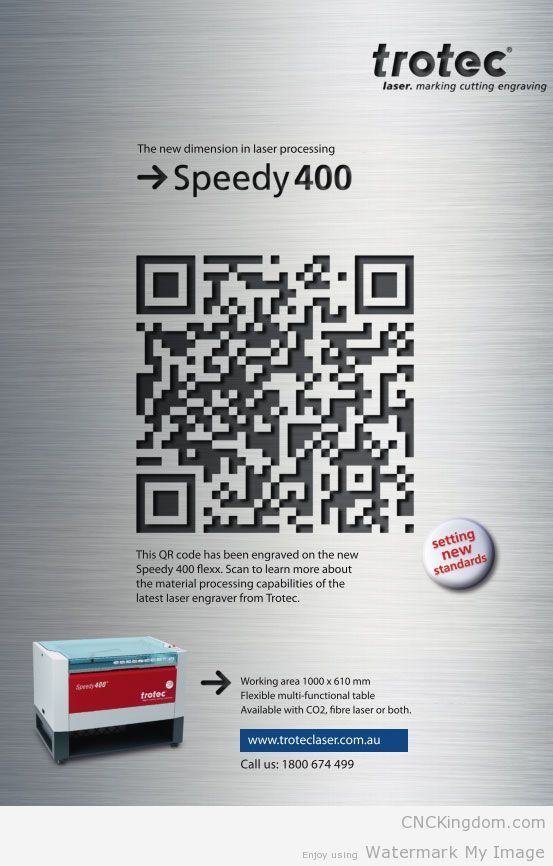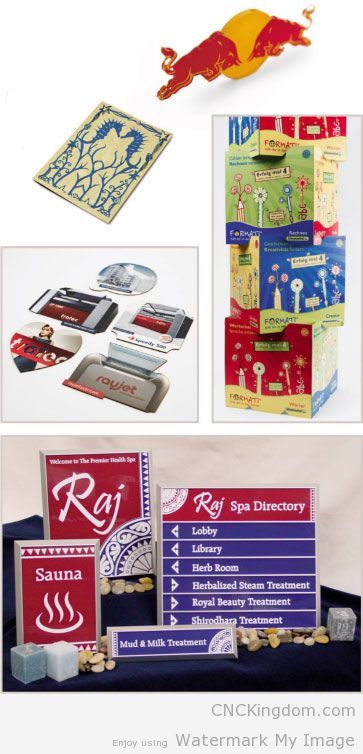What to look for when purchasing a laser engraver
This article was originally written for a buyer’s guide here in Australia. Trotec Laser was kind enough to allow me to share this with the world here on CNCKingdom.com for others to use.
The purchase of a laser system is much more than just adding a new tool to your business. It is an investment in your business and you expect to receive a good return. There may be a number of tools on the market that offer similar results, but not all of them will give you the same return, so your choice of laser system will have a significant impact on your business’s bottom line today and for years to come. To maximize your ROI there are four key considerations:
1 Productivity (speed)
2 Quality and reliability of the machine
3 Flexibility in the type of work that can be done
4 Warranty and service
1. PRODUCTIVITY (SPEED)
While it is obvious that a faster machine will increase your productivity and hence generate more profit in a given time, it can be difficult to evaluate machine speed from manufacturer to manufacturer when shopping around. Many of the manufacturers have stopped publishing engraving speed specifications so this information can be hard to obtain. The salespeople will have presentations that show off the best of their own machines but this does not really tell you how it will perform on your particular jobs.
One option is to take a common file that represents a typical job to each manufacturer and see how long it takes for the system to process the work. Make sure you are comparing similar platforms (i.e. entry level vs. entry level, or industrial level vs. industrial level) and similar laser powers. Lasers are software operated, so make sure that the software offers you the features and benefits you will need to be productive.
You need to focus on which features and functionality will save you time so that the
software does not become irritating later on. Can the software talk in real-time to your laser so you can drag and drop your jobs directly onto the work area and start them from anywhere? Does the software maintain a list of the jobs you have done so that you can find them easily next time? Is there an accurate job timer function that can make quoting easier? Make a list of the things that are important to you, and make sure that each laser you look at has those features.

2. QUALITY AND RELIABILITY OF THE MACHINE
Buying a laser is an investment in your business, and you want to invest in equipment that will last. Build quality is vital to ensure longevity and years of smooth operation, however it can be difficult to assess. There are a few things to look for when assessing build quality.
Build Construction: Check if the laser vibrates or sways when engraving at full speed. This can
be a sign that the chassis is not very rigid and can lead to inconsistent engraving and premature wear. Make sure the machine you choose can machine produce the same quality engraving at all four corners of the working area. Ask each manufacturer for a demonstration that gives the machine a good workout and test all four corners. You may need to use the whole working area on a regular basis, and so you need to ensure that the engraving quality is consistent.
Motion System: You don’t want to spend hours each day cleaning the machine, so check if the bearings or rails are exposed. Can the belts stretch over time? Processing most materials with a laser creates dust and debris that can cause the bearings to dry out and need replacing. It can also collect on the rail and cause inaccuracies in the engraving or cutting. You can check to see how substantial the belts are and if they are reinforced. Some manufacturers take special care to shield the drive belt and rails from dust; choose reinforced drive belts and zero maintenance motion systems (eg. Trotec’s patented In-Packtechnology). This may save you from expensive service bills in the future.
Optics: Are the optics shielded from the dust? Are they easy to clean? Are they high-quality? Ideally, the mirror and lens should be in a solid housing and have positive air pressure from the air assist system to prevent dust from reaching the bottom side of the lens and the top-side of the lens and mirror. Lenses are expensive, and frequent replacements will have a negative effect on your bottom line – but it does not have to be this way.
Laser Tube: The laser tube is the most significant part of any laser – so always choose a high-quality laser tube if you want accurate engraving and reliability. You can see the difference for yourself using a magnifying glass for a closer look. What is the expected life of the tube used by the machine that you are looking at purchasing? How long is the warranty?

3. CHOOSE A LASER THAT OFFERS YOU MORE FLEXIBILITY IN THE TYPE OF WORK YOU CAN DO
The laser system you choose should be configured to meet your existing needs, but
should also give you the opportunity to upgrade as your needs change. What options do you need today, and what can you add tomorrow? The standard options include different work area tables, air assist and rotary attachments, but what if the business changes and you suddenly need to do high-volume metal marking? Can the machine you purchased be upgraded to include a fibre laser source if needed, or would you need to purchase an additional machine?
Perhaps you should consider a machine that includes both laser sources in the beginning to give you the maximum amount of flexibility. It is also worthwhile asking your prospective supplier directly what they will do to help you as your business grows and changes.
4. WARRANTY AND SERVICE
You can’t make money when your machine is not working, so warranty and service are vital to keep your business running. How quickly will the manufacturer be able to fix your machine in the event of a break down? Will it be covered under warranty, or is there a long list of exclusions?
Any quality laser system should have an industry leading warranty to back it up. The length of the warranty is often a direct reflection on the lasers quality and potential lifespan. Comparing the length of the warranty offered by manufacturers is obvious, but also check to see if belts, bearings and motors are covered, or are they considered as consumable or ‘wear and tear parts’?
It is also worth finding out whether the manufacturer is willing to offer extended warranty, and if so, for how long? You should also ask who does the service, and where? Is it the local distributor or a factory overseas? Does it cost you anything? Are the service technicians experienced? Have they been factory trained? How long will a service take? Will parts have to be shipped in from overseas – is there a wait for parts? Are parts stocked locally?
Finally, consider what type of training is available and whether it is ongoing and if any costs are involved. Does the manufacturer conduct training locally? Facing the prospect of operating a new piece of equipment that contributes to your livelihood is daunting, so having peace of mind that you will be provided with ongoing training and support from the manufacturer
may be a deciding factor for you. All of these factors will determine how much it costs you to run the laser and how much the laser will make you in profits. Over the life of the system, this adds up to your overall return. Smart buyers never judge a laser on purchase price alone, be aware of potential running costs for each laser you evaluate, as there can be a considerable difference between brands.
All the elements above that contribute to the total cost of ownership for the life of the machine. Always compare the total cost of ownership – it can save you thousands.
You can find-out more about Trotec Laser at TrotecLaser.com.au (Australia) or TrotecLaser.com (worldwide).

